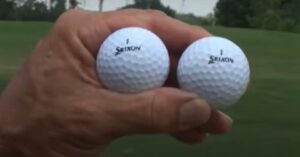Why Are Golf Balls Numbered? Unveiling The Mystery
Have you ever wondered why golf balls have numbers on them? It’s not just for decoration! The numbers on golf balls serve a very important purpose: they help golfers identify their balls.
In golf, players often use the same type of golf ball, which can make tracking their own ball challenging. The numbers on golf balls solve this problem by providing a quick and easy way for golfers to identify their balls, even in grassy areas or water hazards.
In this blog post, we’ll delve into the rationale behind this numbering system and shed light on its significance. So, let’s satisfy our curiosity and unravel the mystery behind the numbers on golf balls.
The Purpose Of Golf Ball Numbers

When it comes to the game of golf, every detail counts, including the numbers on the golf balls. These seemingly insignificant digits serve a crucial purpose for golfers of all skill levels.
Let’s delve into the various reasons why golf ball numbers play such an important role on the course.
To Help Golfers Identify Their Own Balls
One of the primary purposes of golf ball numbers is to assist golfers in easily identifying their own balls amidst a sea of similar-looking spheres.
When multiple players are using the same brand and type of ball, it can be challenging to tell them apart.
The numbers on the balls come to the rescue by providing a quick and effortless way for golfers to distinguish their own balls, even in grassy areas or water hazards.
To Prevent Confusion In Group Play
The presence of numbers on golf balls also serves to prevent confusion, particularly during group play.
This purpose closely relates to the first one mentioned. Without numbers on the balls, it becomes all too easy for players to mistakenly hit the wrong ball.
This can result in penalties and disrupt the flow of the game. By having clear and distinct numbers on their balls, golfers can avoid such mishaps and ensure a smoother and fairer playing experience.
To Help Golfers Track Their Performance
For some golfers, keeping track of the number of balls they hit can be a valuable tool for tracking their performance.
By analyzing the patterns associated with different ball numbers, golfers can gain insights into their game. They may discover, for example, that they consistently achieve better shots with specific numbered balls.
Armed with this information, golfers can identify the factors contributing to their success and make adjustments to improve their overall game.
To Help Golfers Customize Their Balls
Golfers often find joy in personalizing their equipment, and golf balls are no exception. Many players take advantage of the space provided by the ball’s number to add their own personal touch.
Whether it’s adding their lucky numbers, initials, or other unique markings, customizing their balls helps golfers feel a stronger connection to their equipment. Additionally, these personalized markings make it even easier for golfers to identify their own balls at a glance.
To Help Golfers Track Their Inventory
Beyond individual play, golf ball numbers also serve a practical purpose for golf courses and businesses that sell golf balls.
Keeping track of the number of balls in stock allows these establishments to manage their inventory effectively.
It helps prevent theft and ensures that they always have an ample supply of balls to meet customer demand.
The Different Types Of Golf Ball Numbers

Golf balls are an essential part of the game, and they come with different types of numbers. Understanding the various types of golf ball numbers can help players choose the right ball for their game.
Single-Digit Numbers
Single-digit numbers on golf balls are typically used to indicate the compression rating of the ball. The compression rating refers to the degree of hardness or softness of the ball. A lower compression rating means the ball is softer, which can help players with slower swing speeds.
Two-Digit Numbers
Two-digit numbers on golf balls are often used to identify the brand or model of the ball. For example, Titleist Pro V1 has the number 1 on it. The number 1 indicates that the ball is part of the Pro V1 series.
Three-Digit Numbers:
Three-digit numbers on golf balls are often used to identify the specific type of ball within a brand or model. For example, Titleist Pro V1x has the number 100 on it. The number 100 indicates that the ball is a Pro V1x with a specific design or construction.
Four or Five-Digit Numbers:
Four or five-digit numbers on golf balls are typically used for identification purposes. These numbers help players keep track of their ball during a game, especially when playing with others who are using the same brand and type of ball.
Some players may also use custom numbers to add a personal touch to their golf balls.
The Benefits And Risks Of Golf Ball Numbers

Golf ball numbers are a common feature of most golf balls. They are typically single-digit numbers, ranging from 1 to 4, and are printed on the ball’s surface.
While they may seem like a simple aesthetic choice, golf ball numbers actually serve a number of important purposes.
Benefits of Golf Ball Numbers
- Increased accuracy: Golf ball numbers can help golfers identify their own balls more easily, which can lead to increased accuracy. This is especially important in crowded fairways or greens, where it can be easy to mistake one ball for another.
- Reduced confusion: Golf ball numbers can also help to reduce confusion, especially when multiple players are using the same brand and type of ball. This is because it can be difficult to tell the balls apart without numbers.
- Improved performance tracking: Some golfers keep track of the number of balls they hit. This can help them to see patterns in their game and identify areas where they need to improve.
Risks of Golf Ball Numbers
While golf ball numbers offer a number of benefits, there are also some potential risks associated with them.
- Can be easily mistaken for other objects: Golf ball numbers can sometimes be mistaken for other objects, such as leaves or pebbles. This can lead to golfers hitting the wrong ball, which can result in penalties or other problems.
- Can be used to cheat: Golf ball numbers can also be used to cheat. For example, a player could mark their ball with a different number than the one they are actually using. This could give them an unfair advantage over other players.
- Can be difficult to see in certain conditions: Golf ball numbers can sometimes be difficult to see in certain conditions, such as low light or heavy rain. This can make it difficult for golfers to identify their own balls, which can lead to problems.
Overall, golf ball numbers offer a number of benefits, but there are also some potential risks associated with them. It is important for golfers to weigh the pros and cons before deciding whether or not to use golf ball numbers.
How To Choose The Right Golf Ball Numbers

Choosing the right golf ball numbers can have a significant impact on a player’s game. With so many options available, it can be challenging to know where to start.
Here are some tips for choosing the right golf ball numbers.
Consider Your Skill Level
One of the most important factors to consider when choosing golf ball numbers is your skill level. Players with slower swing speeds may benefit from a lower compression rating, which is often indicated by a single-digit number.
More experienced players may prefer a higher compression rating for better control and distance.
Think About Brand and Model
Different brands and models of golf balls have different numbering systems. Two-digit numbers on golf balls are often used to identify the brand or model of the ball
For example, Titleist Pro V1 has the number 1 on it. Consider trying out different brands and models to see which ones work best for your game.
Personalized Numbers
Many golfers choose to personalize their golf ball numbers with their initials, lucky numbers, or other designs.
While this can add a personal touch to the game, it’s important to consider the potential risks of distraction or confusion for other players.
Consider the Conditions
Finally, consider the conditions in which you will be playing. Different weather conditions and course types may require different types of golf balls.
For example, a softer ball may work better on wet or soft courses, while a harder ball may work better on dry or hard courses.
Frequently Asked Question
Golf balls are numbered for several important reasons, allowing players to easily identify and track their balls during a game.
Here are some frequently asked questions about the numbering of golf balls:
Why Are Golf Balls Numbered With Digits?
Golf balls are numbered with digits (typically from 1 to 4) to indicate their compression rating. Lower numbers are associated with softer balls, providing greater control and spin.
Higher numbers represent firmer balls that offer more distance.
What Is The Purpose Of The Numbering System?
The numbering system helps golfers distinguish their balls from those of others on the course. By assigning unique numbers to each ball, players can identify their own and prevent confusion when playing in groups or during tournaments.
Do All Golf Balls Have Numbers?
Yes, virtually all golf balls on the market have numbers. The numbering system is a standard practice in golf, ensuring consistency across different brands and models. However, some novelty or promotional balls may not have numbers.
Can I Choose Any Number For My Golf Ball?
While you may have a personal preference for a specific number, such as your lucky number, the assigned numbers on golf balls are predetermined by the manufacturer. Golfers can choose from the available options when selecting a brand and model of ball.
Are There Any Rules Or Regulations Regarding Golf Ball Numbers?
There are no specific rules or regulations governing the numbers on golf balls. As long as the ball conforms to the standards set by the governing bodies of golf, such as the USGA (United States Golf Association) or R&A (The Royal and Ancient Golf Club of St Andrews), the numbering is a matter of personal preference.
Conclusion
Golf balls are numbered to help players easily identify their own balls during a game.
The numbers prevent confusion, aid in performance tracking, allow for personalization, and help golf courses manage their inventory.
While there are benefits to using golf ball numbers, players should also be aware of potential risks associated with them.
Ultimately, choosing the right golf ball numbers depends on factors such as skill level, brand and model preferences, and playing conditions.




![How to Clean Golf Balls? [Proven Methods for a Spotless Shine] How-to-Clean-Golf-Balls](https://giftedgolfers.com/wp-content/uploads/2023/09/How-to-Clean-Golf-Balls-300x157.jpg)
